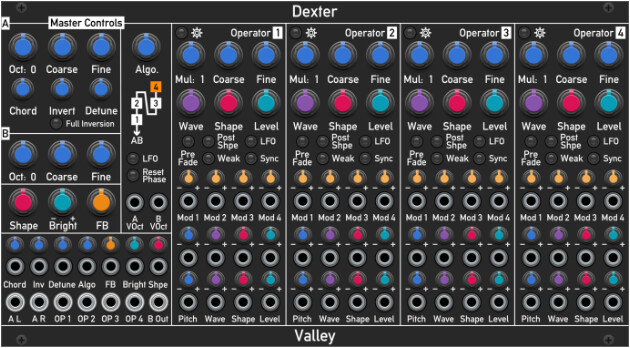I’m watching this video but I find it hard to get started.
Is there any Valley Dexter preset store for lazy users?

I’m watching this video but I find it hard to get started.
Is there any Valley Dexter preset store for lazy users?

I don’t know of any patch collection for Valley Dexter. Also not of any conversion from Yamaha 4 operator FM patches to Dexter (as far as this is even possible).
About Dexter’s functionality. There’s a lot of it. It offer a lot more then a basic 4 operator FM (PM) synthesizer like the Yamaha DX-series 4 operator synths. It has many additional features that vastly add to the sonic options.
In general:
Programming Dexter, especially with limited knowledge of FM/PM synthesis, is a bit of a challenge. But hey, why not try anyway?
Luckily Dexter is excellently documented on the Vally site: Dexter (valleyaudio.github.io). And so is Terrorform: Terrorform (valleyaudio.github.io)
For those who do want to give programming Dexter / FM / PM a try…
In general…FM/PM simplified…
The amount of options and interactions can soon be pretty overwhelming…
So…there is a reason why limiting waveshapes to sines and limiting the amount of algorithms and feedback paths are the most predictable/manageable option.
Other waveshapes then sines contain multiple frequencies/harmonics at various ranks and amplitudes. This can soon generate way to many sidebands, resulting in very complex spectra and soon…chaos/noise.
I got 10 when I was subscribed to Omri Cohen’s patreon. Could always sign up for a month at the Magic Mushrooms level to get a few presets and patches - he has created hundreds!
Worth it for the monthly presets alone, loads for all sorts of modules like Energy, Clouds etc
Probably it would have been wiser for me to open a topic with a slightly more ambitious title:
“Valley Dexter preset competition - submit your best presets here!”
![]()
(…I mean it did work for DanT in case of the cowbell module.)
well… I got a grand total of 4 presets, so yeah, it worked-ish…
All @kwurqx said is true and well said, I’d add that because all modulators do is change the timbre of carriers through their action (modulating the phase), a big part of programming an FM synth is controlling the amplitudes.
If a modulator’s amplitude is 0, there is no modulation, the carrier remains a sine. If its modulator’s amplitude is rising up, its shape starts to change, and sidebands appear. The bigger the amplitude of the modulator, the brighter the carrier, so as a temporary shortcut you can think of the enveloppe controlling the modulator’s amplitude as you usually think about the filter’s enveloppe in a classic subtractive synth.
In the end, FM is about :
Here is the caveat about Dexter, correct me if I’m wrong, but this does not have any enveloppe. So it is not that easy to do “presets” for it, because you’re missing the most important part.
Not ! ![]() How do you save the AD module in Dexter’s preset ?
How do you save the AD module in Dexter’s preset ?
The note was only about why I personally think that Dexter is not a really good way to offer ready-to-play presets, not about its ability to be s good FM module…
This is why moving to Stoermelder STRIP presets is a better idea than individual module presets IMO
Could you, or anybody else check if the V/oct CV input is WRONG in the latest Dexed 2.4.3, it’s 1/10 of the V1 version.
I think the max pitch depth is 0.1 but it should be 1.
Edit 3rd november 2023 : using the V/Oct A and B work as expected, but I still can’t change the whole range of Algos via CV. (and it’s not backward compatible with V 1)
I came across this tutorial which is a good guide; and it shows one way to hook up an envelope, but sadly no presets.
Dexter Tutorial.vcv (14.0 KB)
Here are some presets I have gathered over the years from other people’s patches. Some of these depend on different outputs from Dexter to work properly.
Dubby Chords.vcvm (8.0 KB) Test06.vcvm (7.8 KB) Galaxy3 Church Organ.vcvm (8.2 KB) 4Chordex.vcvm (8.1 KB) Galactose.vcvm (8.1 KB)
Dex Church.vcvm (8.2 KB) Ice Drone.vcvm (7.9 KB) Robotic Waves.vcvm (8.1 KB) Amalgamations.vcvm (8.0 KB) Berlin.vcvm (8.1 KB)
You may have seen my reply on GH, but I have now fixed this issue and waiting on the library team to integrate my latest version.